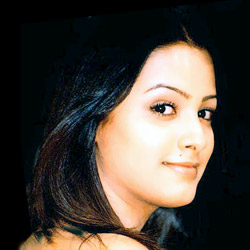Source (Google.com.pk)
Television Actress Biography
Television (TV) is a telecommunication medium for transmitting and receiving moving images that can be monochrome (black-and-white) or colored, with or without accompanying sound. "Television" may also refer specifically to a television set, television programming, or television transmission.
The etymology of the word has a mixed Latin and Greek origin, meaning "far sight": Greek tele (τῆλε), far, and Latin visio, sight (from video, vis- to see, or to view in the first person).
Commercially available since the late 1920s, the television set has become commonplace in homes, businesses and institutions, particularly as a vehicle for advertising, a source of entertainment, and news. Since the 1950s, television has been the main medium for molding public opinion.[1] Since the 1970s the availability of video cassettes, laserdiscs, DVDs and now Blu-ray Discs, have resulted in the television set frequently being used for viewing recorded as well as broadcast material. In recent years Internet television has seen the rise of television available via the Internet, e.g. iPlayer and Hulu.
Although other forms such as closed-circuit television (CCTV) are in use, the most common usage of the medium is for broadcast television, which was modeled on the existing radio broadcasting systems developed in the 1920s, and uses high-powered radio-frequency transmitters to broadcast the television signal to individual TV receivers.
The broadcast television system is typically disseminated via radio transmissions on designated channels in the 54–890 MHz frequency band.[2] Signals are now often transmitted with stereo or surround sound in many countries. Until the 2000s broadcast TV programs were generally transmitted as an analog television signal, but in 2008 the USA went almost exclusively digital.
A standard television set comprises multiple internal electronic circuits, including those for receiving and decoding broadcast signals. A visual display device which lacks a tuner is properly called a video monitor, rather than a television. A television system may use different technical standards such as digital television (DTV) and high-definition television (HDTV). Television systems are also used for surveillance, industrial process control, and guiding of weapons, in places where direct observation is difficult or dangerous. Some studies have found a link between infancy exposure to television and ADHD.
In its early stages of development, television employed a combination of optical, mechanical and electronic technologies to capture, transmit and display a visual image. By the late 1920s, however, those employing only optical and electronic technologies were being explored. All modern television systems relied on the latter, although the knowledge gained from the work on electromechanical systems was crucial in the development of fully electronic television.
Braun HF 1 television receiver, Germany, 1958
The first images transmitted electrically were sent by early mechanical fax machines, including the pantelegraph, developed in the late nineteenth century. The concept of electrically powered transmission of television images in motion was first sketched in 1878 as the telephonoscope, shortly after the invention of the telephone. At the time, it was imagined by early science fiction authors, that someday that light could be transmitted over copper wires, as sounds were.
The idea of using scanning to transmit images was put to actual practical use in 1881 in the pantelegraph, through the use of a pendulum-based scanning mechanism. From this period forward, scanning in one form or another has been used in nearly every image transmission technology to date, including television. This is the concept of "rasterization", the process of converting a visual image into a stream of electrical pulses.
In 1884 Paul Gottlieb Nipkow, a 23-year-old university student in Germany,[4] patented the first electromechanical television system which employed a scanning disk, a spinning disk with a series of holes spiraling toward the center, for rasterization. The holes were spaced at equal angular intervals such that in a single rotation the disk would allow light to pass through each hole and onto a light-sensitive selenium sensor which produced the electrical pulses. As an image was focused on the rotating disk, each hole captured a horizontal "slice" of the whole image.[5]
Nipkow's design would not be practical until advances in amplifier tube technology became available. Later designs would use a rotating mirror-drum scanner to capture the image and a cathode ray tube (CRT) as a display device, but moving images were still not possible, due to the poor sensitivity of the selenium sensors. In 1907 Russian scientist Boris Rosing became the first inventor to use a CRT in the receiver of an experimental television system. He used mirror-drum scanning to transmit simple geometric shapes to the CRT.[6]
Vladimir Zworykin demonstrates electronic television (1929).
Using a Nipkow disk, Scottish inventor John Logie Baird succeeded in demonstrating the transmission of moving silhouette images in London in 1925,[7] and of moving, monochromatic images in 1926. Baird's scanning disk produced an image of 30 lines resolution, just enough to discern a human face, from a double spiral of Photographic lenses.[8] This demonstration by Baird is generally agreed to be the world's first true demonstration of television, albeit a mechanical form of television no longer in use. Remarkably, in 1927 Baird also invented the world's first video recording system, "Phonovision": by modulating the output signal of his TV camera down to the audio range, he was able to capture the signal on a 10-inch wax audio disc using conventional audio recording technology. A handful of Baird's 'Phonovision' recordings survive and these were finally decoded and rendered into viewable images in the 1990s using modern digital signal-processing technology.[9]
In 1926, Hungarian engineer Kálmán Tihanyi designed a television system utilizing fully electronic scanning and display elements, and employing the principle of "charge storage" within the scanning (or "camera") tube.[10][11][12][13]
On December 25, 1926, Kenjiro Takayanagi demonstrated a television system with a 40-line resolution that employed a CRT display at Hamamatsu Industrial High School in Japan.[14] This was the first working example of a fully electronic television receiver. Takayanagi did not apply for a patent.[15]
By 1927, Russian inventor Léon Theremin developed a mirror-drum-based television system which used interlacing to achieve an image resolution of 100 lines.[16]
Philo Farnsworth
In 1927, Philo Farnsworth made the world's first working television system with electronic scanning of both the pickup and display devices,[17] which he first demonstrated to the press on 1 September 1928.[17][18]
WRGB claims to be the world's oldest television station, tracing its roots to an experimental station founded on January 13, 1928, broadcasting from the General Electric factory in Schenectady, NY, under the call letters W2XB.[19] It was popularly known as "WGY Television" after its sister radio station. Later in 1928, General Electric started a second facility, this one in New York City, which had the call letters W2XBS, and which today is known as WNBC. The two stations were experimental in nature and had no regular programming, as receivers were operated by engineers within the company. The image of a Felix the Cat doll, rotating on a turntable, was broadcast for 2 hours every day for several years, as new technology was being tested by the engineers.
In 1936 the Olympic Games in Berlin were carried by cable to television stations in Berlin and Leipzig where the public could view the games live.[20]
In 1935 the German firm of Fernseh A.G. and the United States firm Farnsworth Television owned by Philo Farnsworth signed an agreement to exchange their television patents and technology to speed development of television transmitters and stations in their respective countries.[21]
On 2 November 1936 the BBC began transmitting the world's first public regular high-definition service from the Victorian Alexandra Palace in north London.[22] It therefore claims to be the birthplace of television broadcasting as we know it today.
In 1936, Kálmán Tihanyi described the principle of plasma display, the first flat panel display system.[23][24]
Mexican inventor Guillermo González Camarena also played an important role in early television. His experiments with television (known as telectroescopía at first) began in 1931 and led to a patent for the "trichromatic field sequential system" color television in 1940,.[25]
Although television became more familiar in the United States with the general public at the 1939 World's Fair, the outbreak of World War II prevented it from being manufactured on a large scale until after the end of the war. True regular commercial television network programming did not begin in the U.S. until 1948. During that year, legendary conductor Arturo Toscanini made his first of ten TV appearances conducting the NBC Symphony Orchestra,[26] and Texaco Star Theater, starring comedian Milton Berle, became television's first gigantic hit show.[27] Since the 1950s, television has been the main medium for molding public opinion.[1]
Amateur television (ham TV or ATV) was developed for non-commercial experimentation, pleasure and public service events by amateur radio operators. Ham TV stations were on the air in many cities before commercial TV stations came on the air.[28]
In 2012, it was reported that television was growing into a larger component of major media companies' revenues than film.










Television Actress Biography
Television (TV) is a telecommunication medium for transmitting and receiving moving images that can be monochrome (black-and-white) or colored, with or without accompanying sound. "Television" may also refer specifically to a television set, television programming, or television transmission.
The etymology of the word has a mixed Latin and Greek origin, meaning "far sight": Greek tele (τῆλε), far, and Latin visio, sight (from video, vis- to see, or to view in the first person).
Commercially available since the late 1920s, the television set has become commonplace in homes, businesses and institutions, particularly as a vehicle for advertising, a source of entertainment, and news. Since the 1950s, television has been the main medium for molding public opinion.[1] Since the 1970s the availability of video cassettes, laserdiscs, DVDs and now Blu-ray Discs, have resulted in the television set frequently being used for viewing recorded as well as broadcast material. In recent years Internet television has seen the rise of television available via the Internet, e.g. iPlayer and Hulu.
Although other forms such as closed-circuit television (CCTV) are in use, the most common usage of the medium is for broadcast television, which was modeled on the existing radio broadcasting systems developed in the 1920s, and uses high-powered radio-frequency transmitters to broadcast the television signal to individual TV receivers.
The broadcast television system is typically disseminated via radio transmissions on designated channels in the 54–890 MHz frequency band.[2] Signals are now often transmitted with stereo or surround sound in many countries. Until the 2000s broadcast TV programs were generally transmitted as an analog television signal, but in 2008 the USA went almost exclusively digital.
A standard television set comprises multiple internal electronic circuits, including those for receiving and decoding broadcast signals. A visual display device which lacks a tuner is properly called a video monitor, rather than a television. A television system may use different technical standards such as digital television (DTV) and high-definition television (HDTV). Television systems are also used for surveillance, industrial process control, and guiding of weapons, in places where direct observation is difficult or dangerous. Some studies have found a link between infancy exposure to television and ADHD.
In its early stages of development, television employed a combination of optical, mechanical and electronic technologies to capture, transmit and display a visual image. By the late 1920s, however, those employing only optical and electronic technologies were being explored. All modern television systems relied on the latter, although the knowledge gained from the work on electromechanical systems was crucial in the development of fully electronic television.
Braun HF 1 television receiver, Germany, 1958
The first images transmitted electrically were sent by early mechanical fax machines, including the pantelegraph, developed in the late nineteenth century. The concept of electrically powered transmission of television images in motion was first sketched in 1878 as the telephonoscope, shortly after the invention of the telephone. At the time, it was imagined by early science fiction authors, that someday that light could be transmitted over copper wires, as sounds were.
The idea of using scanning to transmit images was put to actual practical use in 1881 in the pantelegraph, through the use of a pendulum-based scanning mechanism. From this period forward, scanning in one form or another has been used in nearly every image transmission technology to date, including television. This is the concept of "rasterization", the process of converting a visual image into a stream of electrical pulses.
In 1884 Paul Gottlieb Nipkow, a 23-year-old university student in Germany,[4] patented the first electromechanical television system which employed a scanning disk, a spinning disk with a series of holes spiraling toward the center, for rasterization. The holes were spaced at equal angular intervals such that in a single rotation the disk would allow light to pass through each hole and onto a light-sensitive selenium sensor which produced the electrical pulses. As an image was focused on the rotating disk, each hole captured a horizontal "slice" of the whole image.[5]
Nipkow's design would not be practical until advances in amplifier tube technology became available. Later designs would use a rotating mirror-drum scanner to capture the image and a cathode ray tube (CRT) as a display device, but moving images were still not possible, due to the poor sensitivity of the selenium sensors. In 1907 Russian scientist Boris Rosing became the first inventor to use a CRT in the receiver of an experimental television system. He used mirror-drum scanning to transmit simple geometric shapes to the CRT.[6]
Vladimir Zworykin demonstrates electronic television (1929).
Using a Nipkow disk, Scottish inventor John Logie Baird succeeded in demonstrating the transmission of moving silhouette images in London in 1925,[7] and of moving, monochromatic images in 1926. Baird's scanning disk produced an image of 30 lines resolution, just enough to discern a human face, from a double spiral of Photographic lenses.[8] This demonstration by Baird is generally agreed to be the world's first true demonstration of television, albeit a mechanical form of television no longer in use. Remarkably, in 1927 Baird also invented the world's first video recording system, "Phonovision": by modulating the output signal of his TV camera down to the audio range, he was able to capture the signal on a 10-inch wax audio disc using conventional audio recording technology. A handful of Baird's 'Phonovision' recordings survive and these were finally decoded and rendered into viewable images in the 1990s using modern digital signal-processing technology.[9]
In 1926, Hungarian engineer Kálmán Tihanyi designed a television system utilizing fully electronic scanning and display elements, and employing the principle of "charge storage" within the scanning (or "camera") tube.[10][11][12][13]
On December 25, 1926, Kenjiro Takayanagi demonstrated a television system with a 40-line resolution that employed a CRT display at Hamamatsu Industrial High School in Japan.[14] This was the first working example of a fully electronic television receiver. Takayanagi did not apply for a patent.[15]
By 1927, Russian inventor Léon Theremin developed a mirror-drum-based television system which used interlacing to achieve an image resolution of 100 lines.[16]
Philo Farnsworth
In 1927, Philo Farnsworth made the world's first working television system with electronic scanning of both the pickup and display devices,[17] which he first demonstrated to the press on 1 September 1928.[17][18]
WRGB claims to be the world's oldest television station, tracing its roots to an experimental station founded on January 13, 1928, broadcasting from the General Electric factory in Schenectady, NY, under the call letters W2XB.[19] It was popularly known as "WGY Television" after its sister radio station. Later in 1928, General Electric started a second facility, this one in New York City, which had the call letters W2XBS, and which today is known as WNBC. The two stations were experimental in nature and had no regular programming, as receivers were operated by engineers within the company. The image of a Felix the Cat doll, rotating on a turntable, was broadcast for 2 hours every day for several years, as new technology was being tested by the engineers.
In 1936 the Olympic Games in Berlin were carried by cable to television stations in Berlin and Leipzig where the public could view the games live.[20]
In 1935 the German firm of Fernseh A.G. and the United States firm Farnsworth Television owned by Philo Farnsworth signed an agreement to exchange their television patents and technology to speed development of television transmitters and stations in their respective countries.[21]
On 2 November 1936 the BBC began transmitting the world's first public regular high-definition service from the Victorian Alexandra Palace in north London.[22] It therefore claims to be the birthplace of television broadcasting as we know it today.
In 1936, Kálmán Tihanyi described the principle of plasma display, the first flat panel display system.[23][24]
Mexican inventor Guillermo González Camarena also played an important role in early television. His experiments with television (known as telectroescopía at first) began in 1931 and led to a patent for the "trichromatic field sequential system" color television in 1940,.[25]
Although television became more familiar in the United States with the general public at the 1939 World's Fair, the outbreak of World War II prevented it from being manufactured on a large scale until after the end of the war. True regular commercial television network programming did not begin in the U.S. until 1948. During that year, legendary conductor Arturo Toscanini made his first of ten TV appearances conducting the NBC Symphony Orchestra,[26] and Texaco Star Theater, starring comedian Milton Berle, became television's first gigantic hit show.[27] Since the 1950s, television has been the main medium for molding public opinion.[1]
Amateur television (ham TV or ATV) was developed for non-commercial experimentation, pleasure and public service events by amateur radio operators. Ham TV stations were on the air in many cities before commercial TV stations came on the air.[28]
In 2012, it was reported that television was growing into a larger component of major media companies' revenues than film.
Television Actress

Television Actress

Television Actress

Television Actress

Television Actress

Television Actress

Television Actress

Television Actress

Television Actress
 Television Actress
Television Actress
.jpg)

.jpg)
Television Actress

Television Actress

Television Actress

No comments:
Post a Comment